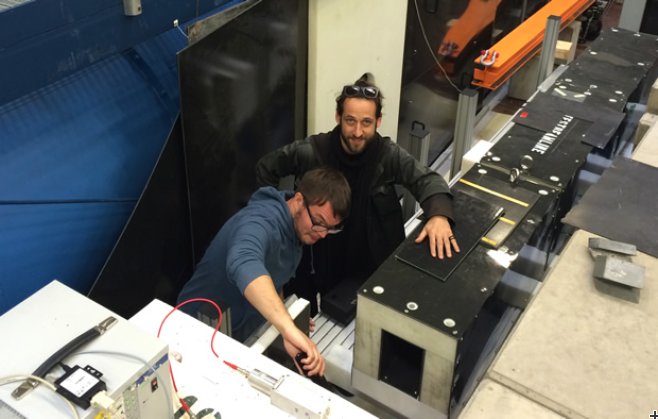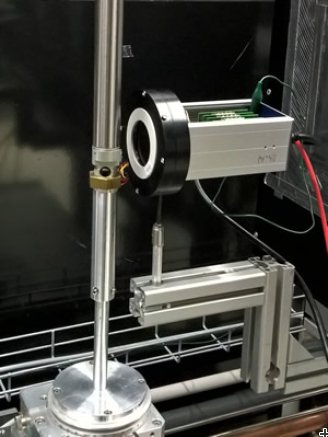Copyright 2012 neutronsources.org | All rights reserved. | Powered by FRM II | Imprint / Privacy Policy
First European Spallation Source Pulse Signature Measured at Helmholtz-Zentrum Berlin
Date: 20/05/2015
Source: http://europeanspallationsource.se
ESS long-pulse structure replicated at HZB. The ESS test beamline will provide real-world conditions for ESS and its partners to test engineering and scientific concepts in the development of instruments and their associated neutron technologies.
BERLIN — The first European Spallation Source (ESS) pulse signature measurement was made last month on the ESS test beamline at Helmholtz-Zentrum Berlin (HZB) in Germany.
The new beamline was designed by ESS Deputy Head of Neutron Instruments Markus Strobl, while latter-stage design and construction were supervised by HZB scientists Tommy Hofmann and Muhammer Bulat in coordination with the HZB engineering department. The three-year project was established in 2010 under the framework of the German In-Kind Contribution to the ESS Design Update Phase, and funded by the BMBF, Germany’s Federal Ministry of Education and Research. Originally coordinated by Strobl at ESS and Klaus Habicht at HZB, ESS has now assumed funding and operations responsibilities for the beamline.
“I fully appreciate that the ESS test beamline is now moving into a phase of user operation and is becoming a useful tool for the development of future neutron methods,” said Habicht, Head of the Department for Methods for Characterization of Transport Phenomena in Energy Materials at HZB.
Eight-disc chopper system allows for Wavelength Frame Multiplication
Constructed at the Berlin Experimental Reactor (BER) II, the beamline will serve as a general-use test bench for the development of novel experimental methods and components for ESS instrument scientists and neutron technology groups working with optics, detectors, choppers, electrical engineering, and other associated technologies. For this reason, the beamline’s design features an elaborate chopper system that mimics the unique long-pulse time structure of ESS.
“The ESS test beamline is an invaluable tool for development purposes,” explains Strobl, who spent several years as a scientist at HZB before coming to ESS as an instrument scientist for neutron imaging. “It represents the first and only Time-of-Flight (ToF) beamline for ESS made operational before the Lund facility will produce its first neutrons in 2019.”
The full 8-disc chopper system on the beamline also allows for wavelength frame multiplication (WFM). WFM is a novel method used to extend the potential wavelength range at a long-pulsed neutron source like ESS. The idea was first suggested by ESS Senior Advisor, and former Director of Machine, Ferenc Mezei, at the 1993 ICANS XII gathering as a method for making long-pulse sources viable and cost-effective. Strobl and scientists at HZB have developed the WFM concept to its current realisation.
WFM systems are applied in a number of instrument designs under development for ESS. With the successful implementation of WFM on the test beamline, this critical design feature of ESS can now be exploited to develop the engineering and methodology for novel neutron scattering techniques unique to the facility.
Hot commissioning and user program have begun
With the resumption of operations at BER II this spring, the ESS pulse signature was finally established on the beamline and the hot commissioning process has begun. Robin Woracek, a postdoctoral scientist with ESS, is based in Berlin to manage the commissioning and operation of the beamline. User support is available for experimentation and consultation for science case and hardware component testing.
The first user experiment is taking place this week, and will test novel ToF imaging detectors, like those required for the ODIN beamline at ESS. The private German companies ProxiVision and Surface Concept GmbH are developing the detectors, and are collaborating with scientists from the ESS Neutron Imaging team for the experiment.
After commissioning of the WFM system is complete, other experiments will move forward. Among those already planned is the testing of a novel spin-echo method combining very-small-angle neutron scattering and imaging. The technique is being developed in a collaboration between HZB, ESS partner institution the Technical University of Delft, and ESS.
Expressions of interest and informal proposals for beam times for testing ESS-relevant techniques are welcome, and should be discussed with and directed to Markus Strobl and Head of ESS Neutron Instruments Division Ken Andersen.
Further reading:
M. Strobl, M. Bulat and K. Habicht
The wavelength frame multiplication chopper system for the ESS test beamline at the BER II reactor – A concept study of a fundamental ESS instrument principle.
Nucl. Inst. Meth. A 705 74-84 (2013).
F. Mezei
Comparison of neutron efficiency of reactor and pulsed source instruments.
Proc. of ICANS-XII (Abingdon 1993) (RAL Report No. 94-025), I-137.


